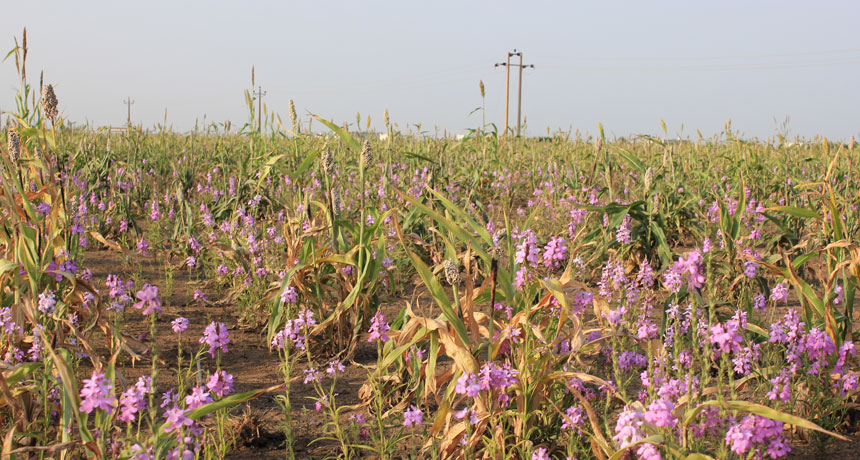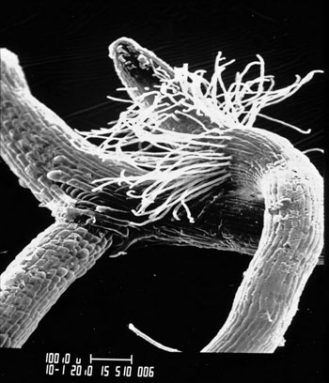Plant ‘vampires’ lay in wait
Study reveals how some weeds sense when to reach out and and begin feeding on a neighbor

These pink flowers may look pretty, but they’re actually parasites that have invaded a field of sorghum, an important gluten-free cereal grain. New research shows how parasitic weeds sense when “food” is near.
Satoko Yoshida
Most plants make their own food. However, some — known as parasites — live by mooching off of others. New research offers surprising insight into how these freeloaders find their hosts. And figuring out how to thwart their tactics might help save our lunch. The new data, for instance, may show farmers how they might protect crops such as rice and beans, which can fall prey to such energy-robbing freeloaders.
Weeds are botanical bullies. They threaten to edge out and sometimes smother valued crops or landscape plants. How might a parasitic weed seed find a new host — its meal ticket? Plants have no eyes or ears. But they can “smell” by sensing chemical signals in the environment around them. Still, they have to be patient. A seed that sprouts with no food nearby risks starving. So seeds of these species will sometimes lurk in the soil for more than a decade, waiting for a signal that it’s time to grow. That wake-up call can come from chemicals known as hormones. Plant roots release these potent signaling compounds.

Parasitic weeds “are like little vampires,” explains David Nelson. A geneticist at the University of Georgia in Athens, he led the new study.
But how those plant hormones signal parasitic plants to grow has puzzled scientists for a long time. In fact, it’s the key question that prompted his team’s new study, which appears in the July 31 Science.
Nelson studies how plants interpret signals in their environment. For the new study, he examined botanical vampires in the Orobanchaceae (Or-oh-ban-KASE-ee-ay) family. This family includes more than 2,000 species. Almost all are parasites, and many are known to damage crops. Nelson looked at how the parasites evolved — gradually changed over generations — to sense strigolactones as growth cues.
‘Mutant’ radios
Scientists had known that wildfires trigger some seeds to sprout. In 2004, research showed that compounds in the smoke called karrikins were the sprouting cue. “It was cool,” Nelson says of the smoke signals. “But nobody knew how they worked.”
To find out, Nelson decided to screen forest plants for genes that would trigger sprouting in response to smoke. It’s a bit like determining which parts of a radio are required for a certain function — for instance, volume control.
If he were a radio geneticist, Nelson says he’d “order 10,000 radios, open them up and randomly break something in each device.” Next, he would look for broken radios that lost volume control — for instance, those that remained permanently loud, or ones that never turned on in the first place.
Lastly, he’d collect all the radios with volume-control problems and open them up to figure out which part was broken.
Nelson and his coworkers used a similar approach to probe how plants sense karrikins. First they used chemicals to induce random changes — mutations — in the plants’ DNA. Then the researchers examined the resulting collection of mutants. They looked for plants that did not sprout in response to smoke. Finally, they compared the genes of these mutant plants against those of plants that sprouted normally after exposure to smoke. The genes that were different in the two groups of plants, they figured, would be the ones that enabled plants to sense the karrikins.
One gene that came out of that screen was a big surprise. Earlier research suggested it was required for something entirely different: responding to strigolactones.
The researchers then discovered two more genes that help plants distinguish one chemical cue from another. One gene carries instructions for making cell features, called receptors, that recognize the presence of karrikins. The other was responsible for receptors that responded to strigolactones.
But there remained a puzzle. Each chemical causes different plant behaviors. Karrikins tell a seed to sprout. Strigolactones typically don’t. In most plants, these hormones act during other stages of development, such as the branching of shoots.
So, how is it that strigolactone triggered sprouting in the vampire plants?
Repurposing for growth
Nelson thought more about strigolactones. They’re complicated. These hormones come in many types. Plants respond to some of them, but not others. And strigolactones don’t just give a boost to freeloading parasites. The compounds also help plants interact with fungi in symbiotic relationships — ones that benefit both organisms.
Nelson wondered if parasitic plants have, over time, come to interpret strigolactones differently. Maybe they adapted their karrikin system to scout for them as sprouting cues.
Experiments detailed in the new Science paper proved this hunch was correct. As parasitic plants evolved, some made extra copies of their gene for the karrikin receptor. Some of the extra copies gained the ability to detect strigolactones. (The process of evolution usually involves random changes to genes that will be passed onto future generations.)
The sprouting-control system in parasitic plants is no longer turned on by karrikins. It evolved, Nelson explains, to be triggered by signals from host plants — those strigolactones.
“It’s pretty clever,” John Yoder told Science News for Students. “A whole system for one purpose has been picked up by these parasites and adapted for a different purpose.” Yoder studies plant genetics at the University of California at Davis. He did not work on the new study.
Michael Timko is a plant biologist at the University of Virginia in Charlottesville. He thinks the findings could help farmers whose crops fall prey to vampire weeds. Understanding better how plants respond to strigolactones, he says, may allow biologists to create special versions of these hormones. Such chemicals might trick parasites into sprouting with no host around. Then the parasites would die of starvation, leaving host crops to thrive and eventually make their way onto our dinner plates.
Power Words
(for more about Power Words, click here)
chemical A substance formed from two or more atoms that unite (become bonded together) in a fixed proportion and structure. For example, water is a chemical made of two hydrogen atoms bonded to one oxygen atom. Its chemical symbol is H2O.
compound (often used as a synonym for chemical) A compound is a substance formed from two or more chemical elements united in fixed proportions. For example, water is a compound made of two hydrogen atoms bonded to one oxygen atom. Its chemical symbol is H2O.
environment The sum of all of the things that exist around some organism or process and the conditions they create for that organism or process. Environment may refer to the weather and ecosystem in which some animal lives, or, perhaps, the temperature, humidity and placement of components in some electronics system or product.
DNA (short for deoxyribonucleic acid) A long, double-stranded and spiral-shaped molecule inside most living cells that carries genetic instructions. In all living things, from plants and animals to microbes, these instructions tell cells which molecules to make.
evolution A process by which species undergo changes over time, usually through genetic variation and natural selection. These changes usually result in a new type of organism better suited for its environment than the earlier type. The newer type is not necessarily more “advanced,” just better adapted to the conditions in which it developed.
fungus (plural: fungi) One of a group of single- or multiple-celled organisms that reproduce via spores and feed on living or decaying organic matter. Examples include mold, yeasts and mushrooms.
gene (adj. genetic) A segment of DNA that codes, or holds instructions, for producing a protein. Offspring inherit genes from their parents. Genes influence how an organism looks and behaves.
genetics Having to do with chromosomes, DNA and the genes contained within DNA. The field of science dealing with these biological instructions is known as genetics. People who work in this field are geneticists.
genetic engineering The direct manipulation of an organism’s genome. In this process, genes can be removed, disabled so that they no longer function, or added after being taken from other organisms. Genetic engineering can be used to create organisms that produce medicines, or crops that grow better under challenging conditions such as dry weather, hot temperatures or salty soils.
gluten A pair of proteins — gliadin and glutenin — joined together and found in wheat, rye, spelt and barley. The bound proteins give bread, cake and cookie doughs their elasticity and chewiness. Some people may not be able to comfortably tolerate gluten, however, because they have an allergy to it or suffer from celiac disease.
hormone (in botany) A chemical that serves as a signaling compound that tells cells of a plant when and how to develop, or when to grow old and die.
host (in biology and medicine) The organism in which another lives. Humans may be a temporary host for food-poisoning germs or other infective agents.
karrikins A family of chemicals that stimulate seeds to sprout. They were discovered in 2003 by Australian scientists. The term comes from an Australian aboriginal word — karrik — meaning smoke.
mutation Some change that occurs to a gene in an organism’s DNA. Some mutations occur naturally. Others can be triggered by outside factors, such as pollution, radiation, medicines or something in the diet. A gene with this change is referred to as a mutant.
organism Any living thing, from elephants and plants to bacteria and other types of single-celled life.
Orobanchaceae A family of flowering plants, commonly known as broomrapes, that are notable for feeding off host plants.
parasite An organism that gets benefits from another species, called a host, but doesn’t provide it any benefits. Classic examples of parasites include ticks, fleas and tapeworms.
sorghum A cereal grain grown throughout the world. In many regions it is grown as a gluten-free food for people. In the United States, most sorghum goes to feed livestock.
species A group of similar organisms capable of producing offspring that can survive and reproduce.
strigolactones A family of plant hormones. They stimulate the growth of certain fungi that offer important benefits to plants.
symbiosis (adj. symbiotic) A relationship between two species that live in close contact. A species that lives this way, offering substantial help to the other species, is sometimes called a symbiont.
weed (in botany) A plant growing wild in, around — and sometimes smothering over — valued plants, such as crops or landscape species (such as lawn grasses, flowers and shrubs). Often a plant becomes such a botanical bully when it enters a new environment with no natural predators or controlling conditions, such as hard frosts. (in biology, generally) Even an animal may be referred to as a “weed” if it enters an environment and begins to overtake the local ecosystem.







